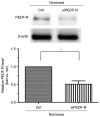PEDF improves cardiac function in rats subjected to myocardial ischemia/reperfusion injury by inhibiting ROS generation via PEDF‑R
- PMID: 29532859
- PMCID: PMC5881792
- DOI: 10.3892/ijmm.2018.3552
PEDF improves cardiac function in rats subjected to myocardial ischemia/reperfusion injury by inhibiting ROS generation via PEDF‑R
Abstract
The prevention and management of myocardial ischemia/reperfusion (MI/R) injury is an essential part of coronary heart disease surgery and is becoming a major clinical problem in the treatment of ischemic heart disease. Previous studies by our group have demonstrated that pigment epithelium‑derived factor (PEDF) improves cardiac function in rats with acute myocardial infarction and reduces hypoxia‑induced cell injury. However, the protective function and mechanisms underlying the effect of PEDF in MI/R injury remain to be fully understood. In the present study, the positive effect of PEDF in MI/R injury was confirmed by construction of the adult Sprague‑Dawley rat MI/R model. PEDF reduced myocardial infarct size and downregulated cardiomyocyte apoptosis in the I/R myocardium in this model. In addition, PEDF improved cardiac function and increased cardiac functional reserve in rats subjected to MI/R Injury. To further study the protective effect of PEDF and the underlying mechanisms in MI/R injury, a H9c2 cardiomyocyte hypoxia/reoxygenation (H/R) model was constructed. PEDF was confirmed to decrease H/R‑induced apoptosis in H9c2 cells, and this anti‑apoptotic function was abolished by pigment epithelium‑derived factor‑receptor (PEDF R) small interfering (si)RNA. Furthermore, administration of PEDF decreased the levels of reactive oxygen species (ROS) and malondialdehyde (MDA) in H/R H9c2 cells. Compared with the H/R group, PEDF decreased mitochondrial ROS, increased the mitochondrial DNA copy number, reduced xanthine oxidase and NADPH oxidase activity, as well as RAC family small GTPase 1 protein expression. However, these effects of PEDF were markedly attenuated by PEDF‑R siRNA. To the best of our knowledge, the present study is the first to identify the protective effect of PEDF in MI/R injury, and confirm that the antioxidative effect PEDF occurred via inhibition of ROS generation via PEDF‑R under MI/R conditions.
Figures







Similar articles
-
Febuxostat pretreatment attenuates myocardial ischemia/reperfusion injury via mitochondrial apoptosis.J Transl Med. 2015 Jul 2;13:209. doi: 10.1186/s12967-015-0578-x. J Transl Med. 2015. PMID: 26136232 Free PMC article.
-
Trimetazidine protects against myocardial ischemia/reperfusion injury by inhibiting excessive autophagy.J Mol Med (Berl). 2018 Aug;96(8):791-806. doi: 10.1007/s00109-018-1664-3. Epub 2018 Jun 29. J Mol Med (Berl). 2018. PMID: 29955901
-
PEDF improves cardiac function in rats with acute myocardial infarction via inhibiting vascular permeability and cardiomyocyte apoptosis.Int J Mol Sci. 2015 Mar 11;16(3):5618-34. doi: 10.3390/ijms16035618. Int J Mol Sci. 2015. PMID: 25768344 Free PMC article.
-
Roles and mechanisms of SUMOylation on key proteins in myocardial ischemia/reperfusion injury.J Mol Cell Cardiol. 2019 Sep;134:154-164. doi: 10.1016/j.yjmcc.2019.07.009. Epub 2019 Jul 22. J Mol Cell Cardiol. 2019. PMID: 31344368 Review.
-
Myocardial ischemia-reperfusion injury, antioxidant enzyme systems, and selenium: a review.Curr Med Chem. 2007;14(14):1539-49. doi: 10.2174/092986707780831078. Curr Med Chem. 2007. PMID: 17584062 Review.
Cited by
-
Epigallocatechin-3-Gallate and PEDF 335 Peptide, 67LR Activators, Attenuate Vasogenic Edema, and Astroglial Degeneration Following Status Epilepticus.Antioxidants (Basel). 2020 Sep 11;9(9):854. doi: 10.3390/antiox9090854. Antioxidants (Basel). 2020. PMID: 32933011 Free PMC article.
-
The m6A methylation enzyme METTL14 regulates myocardial ischemia/reperfusion injury through the Akt/mTOR signaling pathway.Mol Cell Biochem. 2024 Jun;479(6):1391-1400. doi: 10.1007/s11010-023-04808-x. Epub 2023 Jul 12. Mol Cell Biochem. 2024. PMID: 37436654
-
Role of Oxidative Stress in Reperfusion following Myocardial Ischemia and Its Treatments.Oxid Med Cell Longev. 2021 May 18;2021:6614009. doi: 10.1155/2021/6614009. eCollection 2021. Oxid Med Cell Longev. 2021. PMID: 34055195 Free PMC article. Review.
-
Pigment Epithelium-Derived Factor Increases Native Collateral Blood Flow to Improve Cardiac Function and Induce Ventricular Remodeling After Acute Myocardial Infarction.J Am Heart Assoc. 2019 Nov 19;8(22):e013323. doi: 10.1161/JAHA.119.013323. Epub 2019 Nov 13. J Am Heart Assoc. 2019. PMID: 31718448 Free PMC article.
-
PEDF promotes the repair of bone marrow endothelial cell injury and accelerates hematopoietic reconstruction after bone marrow transplantation.J Biomed Sci. 2020 Sep 1;27(1):91. doi: 10.1186/s12929-020-00685-4. J Biomed Sci. 2020. PMID: 32873283 Free PMC article.
References
-
- Damiani G, Salvatori E, Silvestrini G, Ivanova I, Bojovic L, Iodice L, Ricciardi W. Influence of socioeconomic factors on hospital readmissions for heart failure and acute myocardial infarction in patients 65 years and older: Evidence from a systematic review. Clin Interv Aging. 2015;10:237–245. doi: 10.2147/CIA.S71165. - DOI - PMC - PubMed
MeSH terms
Substances
LinkOut - more resources
Full Text Sources
Other Literature Sources
Miscellaneous

